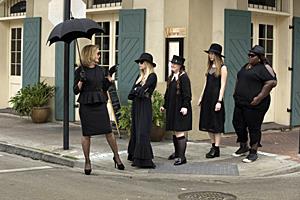If you tally up last week's American Horror Story images, you'll get quite a nightmare laundry list (yes, spoiler alerts, folks). It will include a poisoning, a college party gang-rape, and, in an historical throwback, a 19th-century New Orleans slave unwillingly costumed as an impromptu Minotaur – with an actual hollowed out bloody bull's head for a headdress.
The parade of taboos continues Wednesday night (10 p.m. ET) on FX, with fleeting shots of hangings and satanically slanted sex. This season's AHS miniseries, subtitled Coven and themed around a group of burgeoning teen witches descended from Salem, has Kathy Bates (top) guest-starring as a zombified Creole matriarch exhumed from the grave into modern day. Horror Story isn't without its tongue in cheek humor, though. Tonight, Bates' character, Mme. Delphine LaLaurie, goes pale when she sees and hears an iPhone ringing.
After last season's mishigas of raving psychiatrists gone amok in an insane asylum, you'd think that would have been quite enough shock television, or, as one TVWW reader commented, "torture porn."
But like some kind of Victorian collector's gallery of oddities, this series from Ryan Murphy and Brad Falchuk has its literary roots, and its own kind of ill-sitting beauty as it frames conflicting impulses around gender, sex and power. The Charmed view of teen witches was feather-light; Coven is about as hard-hitting as it gets.
Now three seasons into what can sometimes feel like a perfunctory shock-fest, AHS builds on the 19th century tradition of gothic horror established by Edgar Allan Poe, Robert Louis Stevenson (The Strange Case of Dr. Jekyll and Mr. Hyde), and others. Those stories deliberately plucked at our innate fear reflexes, considered dormant and softened by modern civilization. Turns out, we loved to be scared silly, and that century gave birth to vampires, werewolves and zombies.
Fast-forward to our time, and to the hyper-disturbing Saw and Silent Hill film franchises, which make anything from Stephen King feel like a day at the park. Those films delivered cruel visions, but with a perverse beauty, rendering the deepest nightmares in moody and evocative pictures for all to see.

Their television nephew, FX's
American Horror Story, continues the genre with its tableau of prettified unpleasantries. Often stunningly. Last week, Jessica Lange's character Fiona Goode – the high-flying socialite and the "Supreme" of the witchly Salem descendants – was incensed by a doctor's admonition for her pursuit of an elixir that would deliver renewed youth.
"We're organic, Fiona, we rot and we die," he scolds her. She responds by sucking the life out of him, dropping him to the floor as a sagging corpse in a matter of seconds.
He was right.
With the riveting Lange leading the way, AHS is the rare creature in modern television – an anthology series with a repertory cast. The recurring group includes Sarah Paulson, Frances Conroy and Taissa Farmiga, and gets shuffled around from season to season in different roles. Yet there is – believe it or not – a familial sense to the show. It's kind of an electronic equivalent of campfire ghost stories, delivered each year by favorite cousins. As off-putting as it can sometimes be, American Horror Story oten excels on its visual poetry, as grainy images lurch and pulse on the screen to scratchy and distorted sound effects.
And the series still has legs, so to speak. Tonight's episode resurrects Mary Shelley's Frankenstein theme with, at one point, more than a few dismembered ones laying about a morgue.
As Bates' character recounts after being exhumed from the grave after 180 years, "Hell is real. I've seen it down in that box. Time disappears. The only thing that is left is what's in your mind's eye."
AHS conjures all that up for us in stylish slices. Sometimes literally.